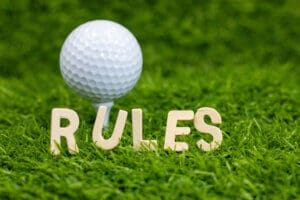The USGA and The R&A announced updates to the Rules of Golf that became effective on January 1, 2023. These regular updates to the Rules are intended to make the game rules easier to understand and apply. In fact, some penalties have been relaxed, and more clear language is used so golfers at all levels of play are more well-informed and prepared for the game. For 2023, one of their focuses was to apply changes to modernize the game, emphasizing inclusion and sustainability. For example, local rules will no longer need to be developed and adopted for disabled players because modified rules are now included within the official rules.
 According to Thomas Pagel, USGA Chief Governance Officer, in an article written by the USGA, “The growing popularity of golf continues to guide our decision-making, and modernizing the Rules to promote inclusivity and accessibility is clearly a great step in the right direction. This latest evolution is especially important to the community of golfers with disabilities, and we hope it will encourage more people to play and enjoy the game.”
According to Thomas Pagel, USGA Chief Governance Officer, in an article written by the USGA, “The growing popularity of golf continues to guide our decision-making, and modernizing the Rules to promote inclusivity and accessibility is clearly a great step in the right direction. This latest evolution is especially important to the community of golfers with disabilities, and we hope it will encourage more people to play and enjoy the game.”
What are the primary changes to the Rules of Golf for 2023?
Here is an overview of some of the most notable changes to the Rules of Golf that were implemented this year:
Modifications for players with disabilities
One of the most significant changes is the inclusion of modifications for players with disabilities. The modifications are designed to allow players with disabilities to compete equally with other golfers. They include several different changes, such as:
- Allowing players with disabilities to use adaptive equipment. This includes things like golf carts, prosthetic limbs, and other devices that help players with disabilities to play the game.
- Allowing players with disabilities to receive assistance from others. This includes help lining up shots, dropping balls, and other tasks that can be difficult for players with disabilities.
- Allowing players with disabilities to take relief from certain hazards. This includes things like embedded balls and water hazards.
The modifications are available to all players who are classified in the categories covered in Rule 25. This includes players with visual and mobility impairments and other disabilities.
Handicap usage in stroke play
With the continued growth of score-posting technology following the adoption of the World Handicap System™, players are no longer penalized for failing to put their handicap on their scorecard in stroke play. The change to the rules regarding handicap usage in stroke play is a positive step for the game.
In the past, golfers were required to put their handicap on their scorecard in stroke play. This was done to ensure that golfers were playing against other golfers of similar ability. However, with the continued growth of score-posting technology following the adoption of the World Handicap System™, it is now possible for committees to easily verify the accuracy of each player’s handicap. As a result, golfers are no longer penalized for failing to put their handicap on their scorecard in stroke play.
The committee is responsible for ensuring the accuracy of each player’s handicap. This can be done by verifying the player’s handicap with the appropriate handicapping authority. The committee can also require players to provide proof of their handicap, such as a copy of their handicap card.
Club damaged during a round.
Under the previous rules, if a player damaged a club during a round, they were not allowed to replace it. This could be a significant problem if the club was damaged beyond repair or if it was the only club of that type that the player had.
The new rule allows players to replace a club damaged during a round, provided the player did not damage it through abuse. This means that players can now replace clubs damaged by normal wear and tear, accidents, or other factors beyond their control. The new rule is a positive change for the game. It makes it easier for players to continue playing when their clubs are damaged, and it helps reduce the number of clubs discarded.
Ball moved by natural forces.
Previous rules said that if natural forces moved a ball at rest, the player was not penalized and had to play it from its new location. However, if natural forces moved the ball after it had been dropped, placed, or replaced, the player was penalized one stroke and had to drop the ball again.
The new rule provides an exception to this penalty. Under the new rule, if natural forces move a ball at rest after it has been dropped, placed, or replaced, the player must return the ball to its original location. This exception prevents players from being penalized for something beyond their control. This update makes it fairer for players, and it helps to reduce the number of penalties that are assessed.
Back-on-the-line relief procedure
The back-on-the-line relief procedure allows golfers to get relief from a ball in a penalty area or unplayable. Under the old rule, golfers had to drop their ball behind the penalty area or unplayable lie, but they had to drop it within two club lengths of the original ball position. This could be difficult to do, especially if the original ball position was in a difficult spot.
The new rule simplifies the back-on-the-line relief procedure by allowing golfers to drop their ball on the line that runs from the hole to the original ball position. The ball must come to rest within one club length of where it is dropped. This makes it easier for golfers to get relief and helps speed up the game.
Spend the day at the Eagle Point Golf Club with us!
Brush up on your golfing skills and get ready for the best season of play at the Eagle Point Golf Club! We encourage our members and guests at the Eagle Point Golf Club to take advantage of personalized tune-up sessions. These mini-lessons help golfers warm up and fine-tune a handful of skills before hitting the greens. During a session, we’ll introduce you to some easy warm-up exercises designed to achieve balance and alignment on the course. And then schedule a tee time for your next game on our website! We can’t wait to see you on the course!

Leave a Reply